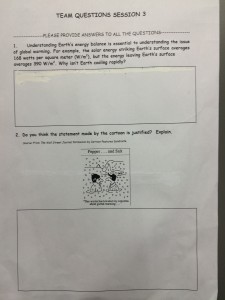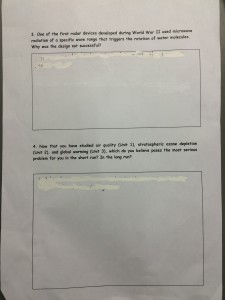Introduction:
This course allows one to have a rough idea on the implications of chemistry on the society through illustrating on the various interaction man has with chemistry. This better allow us to relate to chemistry in our daily life.
Explanation:
Lewis structures and shapes
- Lewis structures,” which combine multiple atoms using electron dot diagrams, and show bonding electrons as well as lone pairs of electrons. It’s very important to know how to draw both electron dot symbols and diagrams, as well as Lewis structures, because you can get a lot of relevant information from these structures, including electron location, number and types of bonds, and geometric structure.
Valence Shell Electron Pair Repulsion Theory
- This theory assumes that each atom in a molecule will achieve a geometry that minimizes the repulsion between electrons in the valence shell of that atom.
IR Spectrum and interaction with molecule
- Infrared Spectroscopy is the analysis of infrared light interacting with a molecule. This can be analyzed in three ways by measuring absorption, emission and reflection. The main use of this technique is in organic and inorganic chemistry. It is used by chemists to determine functional groups in molecules. IR Spectroscopy measures the vibrations of atoms, and based on this it is possible to determine the functional groups. Generally, stronger bonds and light atoms will vibrate at a high stretching frequency (wave number).
3 laws of thermodynamics
- The first law, also known as Law of Conservation of Energy, states that energy cannot be created or destroyed in a chemical reaction.
- The second law of thermodynamics states that the entropy of any isolated system not in thermal equilibrium almost always increases.
- The third law of thermodynamics states that the entropy of a system approaches a constant value as the temperature approaches absolute zero.
Uses of energy
- We divide our energy use among four economic sectors: residential, commercial, transportation, and industrial. Heating and cooling our homes, lighting office buildings, driving cars and moving freight, and manufacturing the products we rely on in our daily lives are all functions that require energy. If projections are correct, we’re going to keep needing more. Global consumption is expected to increase by 44% over the next 2 decades.
References:
- Chemistry in society. (n.d.). Retrieved February 16, 2015, from http://www.educationscotland.gov.uk/highersciences/chemistry/chemistryinsociety/index.asp
- Mulleague, M., Rupawalla, M., Singh, H., Johl, R., & Reid, K. (n.d.). Infrared Spectroscopy. Retrieved March 12, 2015, from http://chemwiki.ucdavis.edu/Physical_Chemistry/Spectroscopy/Vibrational_Spectroscopy/Infrared_Spectroscopy
- Electron Dot Diagrams, Lewis Dot Symbols, and Lewis Structures. (n.d.). Retrieved March 12, 2015, from http://www.wyzant.com/resources/lessons/science/chemistry/lewis_structures_vsepr
- Boundless. “The Three Laws of Thermodynamics.” Boundless Chemistry. Boundless,(n.d.). 01 Dec. 2014. Retrieved 12 Mar. 2015 from https://www.boundless.com/chemistry/textbooks/boundless-chemistry-textbook/thermodynamics-17/the-laws-of-
- Valence-Shell Electron-Pair Repulsion Theory (VSEPR). (n.d.). Retrieved March 12, 2015, from http://chemed.chem.purdue.edu/genchem/topicreview/bp/ch8/vsepr.html
- The National Academies. (n.d.). Retrieved March 12, 2015, from http://needtoknow.nas.edu/energy/energy-use/



